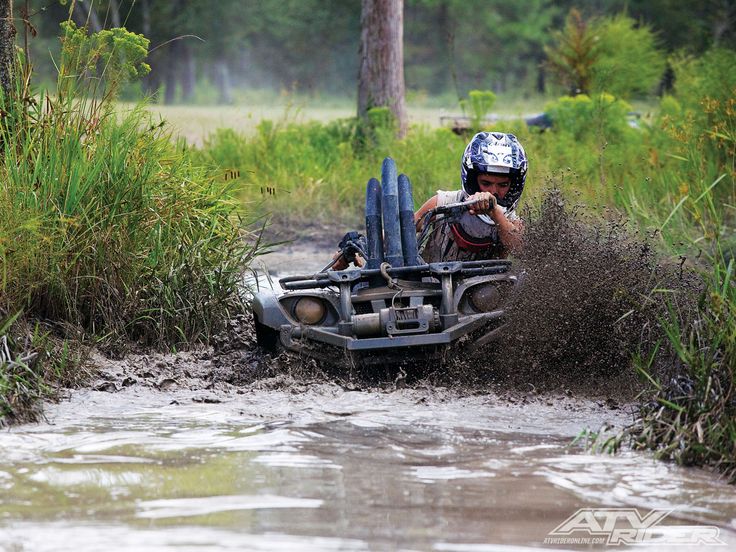All-terrain vehicles (ATV’s) are specifically designed for all types of terrain from mud, to rocks, the plains, and even snow. Snow is by far the most difficult for all vehicles because of the freezing temperatures that coincide with the white stuff. Not only do you have to worry about the sheer amount of snow, which you can get stuck in, but you also have to take into account the freezing temperature that can affect both you and your machine, and make slipping a big issue.
How much snow can an ATV handle? How much snow an ATV can handle depends on the traction you can get. With the right modifications, your ATV should be able to easily tackle upwards of 2 feet of snow in your ATV with the right modifications.
The modifications you will want if you are riding in a lot of snow aim to improve:
The more traction you have, the greater the amount of snow you can traverse in your ATV. The same can be said for power and plowing ability. If you are able to push more snow out of your way, it will make it easier for you to traverse the terrain.
This article will explore what modifications can be made to your ATV that will coincide with the aspects of your ATV as mentioned above. Even if you do not plan to use your ATV for heavy snow terrain, this article will give helpful advice on items or things you should think about when riding your ATV in all types of conditions.
All-terrain vehicles are extremely customizable. You can make your ATV perfectly suited for the type of terrain you will be experiencing when you ride by simply changing out a few parts.
You should always refer back to your owner’s manual to see the lowest temperature at which your ATV can operate. Most owner’s manuals will have outlined ways you can reduce the temperature that your ATV can operate in. Some small, easy steps or additions you can add to your ATV that can help it run at lower temperatures include:

These parts and accessories ensure that your ATV can start in freezing temperatures. The hardest part about cold weather, as any vehicle owner can surely attest to, is getting your vehicle to start up in the below freezing temperatures. Once you get your ATV started, the heat from the engine keeps everything warm and powered so you can go on your adventure.
TiresBy far the most important part of your ATV to consider when determining what terrain you will be facing, ATV tires directly relate to how much traction you will be getting from your ATV. Tires are the part of your ATV that will be in constant contact with the ground and determine whether your ATV will make it in the snow.
Special ATV tires are made for all kinds of terrains. Most tire manufacturers make cheap tires that can be used for “all terrain,” which is a shaky statement at best. In order to get the best performance from your ATV on the type of terrain you will be facing, it is vital that you get the tires made specifically for that terrain.
For snow terrain, you want tires that meet the following categories:
The ridges on the tires are known as tread blocks. They are the raised pattern that fully encompass your tire. The more these ridges protrude outwards from your tire base, the deeper snow your ATV can travel through. The rigid tires dig into the snow and allow you to gain more traction than if you had smooth tires.
Radial paddles are exactly what they sound like. Radial paddles are raised sections on the tire that can span the entire width of the tire. They give the tire the look as if it is the paddle of a paddle boat and function in much the same way as large ridges. Radial paddles are more important than ridges when you are traveling through deep snow as they are able to push you through soft terrain.
They give the tire the look as if it is the paddle of a paddle boat and function in much the same way as large ridges. Radial paddles are more important than ridges when you are traveling through deep snow as they are able to push you through soft terrain.
The raised ribs on snow tires are a combination of both the rigid tread blocks and radial paddles. Raised ribs will be located on tread blocks and look much like the radial paddles. Raised ribs are specially made for moderately deep snow to little amounts of snow so that you can maintain great traction while still having the smoothest ride as possible.
The next aspect of the tire you have to take into account when determining how much snow your ATV will be able to traverse is the width of your tire. You want a wider tire when dealing with deeper snow to spread out the weight of your ATV over a larger area. The more spread out the weight is, the less likely your ATV will sink in the snow and get stuck. The wider the tires means a greater distribution of the weight of your ATV over a larger area.
If you want our recommendation on an excellent snow tire, check out the Maxxis Snow Tires.
Are there Adjustments to Help in Deeper Snow?Yes! There are many adjustments you can make to customize your ATV to make it be able to function and excel in all types of terrain, especially snow. These adjustments can be made to different places of the ATV. You can add accessories to your ATV or add additions to already modified parts on your ATV.
ATV Tracks are the most obvious choice, but they are expensive and limit your riding to only snow. However, if you are riding in deep snow and not on roads or dirt or anything else, replacing your wheels with tracks are your best option to avoid getting stuck.
Tire AccessoriesWith tires being the most important part of your ATV when it comes to traversing over snow, you can further customize them to ensure that you have the best traction possible.
There are two ways you can add traction to your tires through the addition of accessories: chains and ice spikes. Tires chains are the most common way to add traction to your tires in snowy or icy conditions. The downside of having tire chains on your ATV is that you cannot go full speed since the chains could break sending metal chunks flying in all directions.
–These chains are our favorite, but they do come with a hefty price tag-
Ice spikes or studs are rubber spikes on the tire that are cone shaped. The shape allows the tire to be able to grip icy surfaces by poking holes in the ice and gaining traction through that method. These studs are tailored towards travel across ice instead of snow.
-You can find a lot of different options here on Amazon-
WinchEven if you customize your ATV with everything to make it a beast when it comes to traveling through snowy terrain, there is always a possibility that you will get stuck along your journey. When you do get stuck, it could take hours for you to dig your heavy ATV out of the snow. You have to work it back and forth till you get the ATV free which requires a ton of effort.
When you do get stuck, it could take hours for you to dig your heavy ATV out of the snow. You have to work it back and forth till you get the ATV free which requires a ton of effort.
You can save a lot of time and energy by installing a winch on your ATV. The winch allows you to be able to pull your ATV out of snow drift very easily. All you have to do is find a sturdy tree or rock to tie the winch around and turn it on. The winch will do all the hard work of dragging your ATV out of the deep snow.
Check out our Recommended Gear for our Winch recommendations.
LightsIf all else fails and you find yourself completely stuck and unable to get out while on a trail or you are riding your ATV in weather conditions that limit sight range, you need to have plenty of lights on your ATV in order to be seen. The ability to be seen by others is vital for your safety when driving any ATV.
We use the sweet lights from Gorilla Whips, which we reviewed not long ago.
ATV riding in the snow is a ton of fun! If you haven’t done it yet, you need to give it a try. There are some things you can do to make your ride more fun and hit the deeper snow. Just make sure to be careful!
One safety tool I like to have on me when riding in snow or other places I may get stuck is some recovery boards. They are a life saver at getting traction when you need it.
Just because it snows doesn’t mean you have to retire your quad. Here’s how to run an ATV through deep...
By Peter B. Mathiesen | Published Dec 22, 2011 11:39 PM
 It may only last two to four weeks, but the marshes become highways, and you can ride to places where days ago you couldn’t have reached without a boat. Just above the 62nd parallel in Talkeetna, Alaska, the first heavy snow of 2011 fell on November 5th. Here’s how we kept riding through the snow. Pictured: A stout, Yamaha Grizzly 550 EFI with power steering waiting to get dusted off for an Alaskan winter trek. The temp is 7 degrees, and you can bet there’s fuel conditioner in the tank.In deep snow, dropping your key can mean doom. One wrong boot step is all it would have taken to drive this key deep into the snow. I have since tied a piece of pink trail marker tape to the key.Once you’re dragging the frame on snow, it’s time to be concerned. If your bike sinks much below the frame, head to the trailer.Another sign you may be asking too much from your snow-bound ride is if you feel frequent belt slip or smell rubber.You may think that it’s easy to stay dry below freezing, but as the moisture on this seat shows, your choice of pants at 7 degrees may be more important than you think.
It may only last two to four weeks, but the marshes become highways, and you can ride to places where days ago you couldn’t have reached without a boat. Just above the 62nd parallel in Talkeetna, Alaska, the first heavy snow of 2011 fell on November 5th. Here’s how we kept riding through the snow. Pictured: A stout, Yamaha Grizzly 550 EFI with power steering waiting to get dusted off for an Alaskan winter trek. The temp is 7 degrees, and you can bet there’s fuel conditioner in the tank.In deep snow, dropping your key can mean doom. One wrong boot step is all it would have taken to drive this key deep into the snow. I have since tied a piece of pink trail marker tape to the key.Once you’re dragging the frame on snow, it’s time to be concerned. If your bike sinks much below the frame, head to the trailer.Another sign you may be asking too much from your snow-bound ride is if you feel frequent belt slip or smell rubber.You may think that it’s easy to stay dry below freezing, but as the moisture on this seat shows, your choice of pants at 7 degrees may be more important than you think. Once you’re in below-freezing conditions, if there was any water in your winch from a previous ride, it will probably freeze solid. Before you leave, check to make sure the winch is operational.Besides a sleeping bag, space blanket, trash bags, a fire starter kit, and some energy bars, make sure you add at the very least a shovel. A small mechanical come-along is also a good choice. Neither requires a battery, and each will work even if caked in ice.Once it drops down to single digits, your feet need highly-insulated boots that are still flexible enough to feel the brake pedal. These Arctic Pro’s by Muck are a great choice.This photo was taken in late October on a snow machine trail off the Parks Highway in Trapper Creek, Alaska. Check out the red snow depth markers on the poles, they go up to 12 feet!Even though this Honda had aggressive tires, they still weren’t enough to climb out without assistance.This guy had to dig his bike free, and then use cut limbs from cedar trees to get traction.
Once you’re in below-freezing conditions, if there was any water in your winch from a previous ride, it will probably freeze solid. Before you leave, check to make sure the winch is operational.Besides a sleeping bag, space blanket, trash bags, a fire starter kit, and some energy bars, make sure you add at the very least a shovel. A small mechanical come-along is also a good choice. Neither requires a battery, and each will work even if caked in ice.Once it drops down to single digits, your feet need highly-insulated boots that are still flexible enough to feel the brake pedal. These Arctic Pro’s by Muck are a great choice.This photo was taken in late October on a snow machine trail off the Parks Highway in Trapper Creek, Alaska. Check out the red snow depth markers on the poles, they go up to 12 feet!Even though this Honda had aggressive tires, they still weren’t enough to climb out without assistance.This guy had to dig his bike free, and then use cut limbs from cedar trees to get traction. It took him several hours. His shovel and limb saw saved his bacon.Where I live in Alaska, locals need about 12 inches of ice before they’ll roll a quad or snow machine across a lake. Remember, crossing a four-foot wide creek or ditch with ice is one thing; sinking into a 20-foot lake is entirely more dangerous. Be cautious; think carefully before you cross, and never do it alone.
It took him several hours. His shovel and limb saw saved his bacon.Where I live in Alaska, locals need about 12 inches of ice before they’ll roll a quad or snow machine across a lake. Remember, crossing a four-foot wide creek or ditch with ice is one thing; sinking into a 20-foot lake is entirely more dangerous. Be cautious; think carefully before you cross, and never do it alone.Just because it snows doesn’t mean you have to retire your quad. Here’s how to run an ATV through deep snow.
You agree that the maximum speed will be limited for safety reasons
ATVs must be operated by persons over 16 years of age.
The total load on the ATV must not exceed 150 kg.
While driving, the driver must firmly hold on to the steering wheel, the passenger on the special handles.
When cornering, move (tilt) the body in the direction of the turn.
When tilting the ATV, move (tilt) the body in the direction opposite to the slope.
Always keep your feet on the footrests when moving, even when leaning over.
We provide a free instruction on how to drive the ATV before you start using it.
If you notice fluid leaks and/or other problems, stop the engine immediately and notify your instructor.
If you detect the operation of warning signs on the instrument panel (during the initial briefing, you will be shown control devices that you should pay attention to throughout the trip), immediately turn off the engine and inform the instructor.
Before and after the rental, the ATV is checked in your presence for breakdowns and damages, after which the acceptance certificate is signed.
Ride on a quad bike, always wearing helmets only, protective suits are provided free of charge on request.
In the event of a breakdown or accident, inform the instructor or contact him by phone.
If the ATV is damaged due to your fault, you pay the cost of repairs and spare parts.
The time spent during the trip to fix problems that occurred through your fault is not compensated.
You must be instructed in how to operate the ATV before you start using it;
You agree to follow the speed limit set by the guide (instructor).
Do not succumb to the provocations of other citizens to participate in the race; clashes and other actions that can directly or indirectly cause damage to property and citizens;
Do not interfere with your actions or omissions to comply with these rules.
Drive onto highways and other public roads.
To tow other ATVs, or any other vehicles.
Leave ATV unattended.
Crossing deep water obstacles, driving over fires and areas with smoke or open flames is prohibited.
Gear shifting without stopping the machinery.
Drunk or drugged ATV riding.
Intentional collision with other ATVs.
Intentional collision with obstacles.
Provoking others to collide.
Overtake the instructor and the ATVs in front.
Deliberately fall behind the convoy and then overtake the convoy at high speed.
Do not follow the instructions of the instructor.
Touch moving parts such as wheels, drive shafts, variator pulleys, etc.
Talk aggressively, use profanity, and do anything that might disturb the people around you.
• Do not operate the ATV without a properly sized crash helmet. It is also necessary to wear eye protection, (protective mask or goggles).
It is also necessary to wear eye protection, (protective mask or goggles).
• Do not consume alcohol or drugs before or while operating an ATV.
• Always follow the instructions and follow the Instructor's recommendations.
• Before each use, make sure the ATV is in good condition and safe to ride. Always follow the rules and recommendations for driving given in the instruction.
• Always use extreme caution and drive slowly when driving in unfamiliar terrain.
• Always keep both hands on the handlebars and both feet on the footrests while riding the ATV.
• Do not operate the ATV on uneven, slippery, damaged roads until you have learned and gained the practical skills necessary to control the ATV on such roads. Always be extremely careful when driving in such conditions.
• Do not operate the ATV on slopes that are too steep for the vehicle and for your experience. Practice on small descents before moving on to difficult ones.
• Always follow the appropriate instructions from the Instructor when entering a hill, check the road surface first, never enter a hill on a road that is too slippery or has a damaged surface. Shift your weight forward of the ATV, never suddenly open the throttle or change gears suddenly. Never drive up a hill at high speed.
Shift your weight forward of the ATV, never suddenly open the throttle or change gears suddenly. Never drive up a hill at high speed.
• Always follow the appropriate instructions from the Instructor when descending and braking on the hill. Inspect the road carefully before descending. Shift your weight back, never go down a hill at high speed. Avoid going downhill at an angle that could cause the ATV to lean to the side. Go straight down if possible.
• Always follow the appropriate Instructor's instructions for crossing inclines. Avoid slides on excessively slippery or damaged surfaces. Shift your weight to the side of the lift. Never turn the ATV around on a hill until you have mastered the turning technique. On level ground, avoid crossing steep hills whenever possible.
• To prevent the engine from stalling and the vehicle from reversing when entering a hill, use the appropriate gear and maintain a steady speed. If the engine stalls or the vehicle reverses, follow the Instructor's specific instructions.
• Always check for obstacles in the road before operating the ATV in unfamiliar terrain. Never try to overcome large obstacles on the ATV, such as large rocks or fallen trees. Always follow the Instructor's specific instructions for overcoming obstacles.
• Be careful when skidding or skidding when practicing at low speed on a flat, smooth road. On extremely slippery surfaces such as ice, drive slowly and be very careful to reduce the risk of slipping or skidding.
• Start decelerating some time before stopping.
• Be aware that wet brakes reduce stopping power. Check your brakes after getting out of the water, if necessary, wait a while for the pads to dry out.
• Always be sure there are no obstacles or people behind you when you turn.
• Never exceed the ATV's stated load capacity. The load must be properly placed and securely attached.
• Never start the engine on a slope, as this may cause damage.
• Observe age guidelines: children under 16 are not allowed to operate an ATV. Do not allow a person who does not know how to operate the ATV in a safe manner to operate the ATV.
Do not allow a person who does not know how to operate the ATV in a safe manner to operate the ATV.
• Avoid riding the ATV on paved roads, including driveways, sidewalks, streets and car parks.
• If you need to stop (frozen helmet glass, hands, etc.) do not wait for the group to stop. Raise your left hand up (stop signal for ATVs following you) and gently come to a stop.
The instructor has the right to stop the tour early in case of violation of these rules!!!
To prevent ATV riding from ending up in a long hospital room:
Do not drive too fast. A four-wheel drive ATV is not a car or a motorcycle. It doesn't respond as well to the driver as a car, it can't lean quickly into a corner like a motorcycle. Remember that when riding an ATV it is very easy to roll over on level ground or even crash into a tree at full speed. For example, if a stump comes across in a field under tall grass, the ATV can run into it, and then the rider will fly over the steering wheel, or at least hit it.
Never ride an ATV alone. It is best to ride with someone in a pair on two ATVs. There are a lot of situations when a partner is needed. For example, it is very difficult to put an overturned ATV on wheels, and if it covered you from above, then you won’t even be able to get out from under it alone. The second ATV can pull the first one out of the swamp or tow it to the camp in case of a breakdown.
When passing a difficult obstacle, it is better to get out of the saddle and, carefully working with the brake and accelerator, walk alongside. You should also not go too deep into the water - you can fill the motor.
Place both feet straight on the footrests and hands on the controls.
Start the engine, let it warm up. After that, holding the brake, engage the gear.
Select direction of travel.
Release the brake and slowly press the throttle with your right thumb to start moving. The speed of movement depends on how far the damper is open.
The speed of movement depends on how far the damper is open.
For starters, don't try to drive fast. It is better to learn how to maneuver, handle the brake system and throttle on level ground.
Turn the steering wheel in the desired direction. Tilt your upper body inward and rest your weight on the outside footboard. This will change the balance of traction between the wheels, and the turn will be made smoothly. Turns back are performed in the same way.
ATTENTION!!! ATVs are not designed to make sharp turns or turns at high speed!
When entering a slippery surface, slow down.
Avoid sharp and sharp turns, or the ATV will skid.
When skidding, turn the steering wheel in the direction of the skid and shift your body weight forward. Never slow down during a skid.
An all-wheel drive system can make driving on slippery surfaces much easier.
Climb up in a straight path.
ATVs are not designed for climbing steep hills (over 25°).
When lifting, keep both feet on the footrests and shift your body weight forward.
Drive at a steady speed with the throttle open.
When ascending, be fully prepared for an emergency.
If the ATV has completely lost forward speed, raise yourself up and apply the front brake. If there is a complete stop, apply the rear brake as well, and then set the gear selector to park.
If the machine rolls backward, it is necessary to get up and apply the front brake. After a complete stop, you can also apply the rear brake and move the gear selector to park mode.
ATTENTION!!! Crossing hills on an ATV is very dangerous! If possible, try to avoid hills when riding an ATV. Any incorrect action while crossing a hill can cause serious injury, or even death!!!
Any incorrect action while crossing a hill can cause serious injury, or even death!!!
If you still need to cross a hill with an ATV, please follow these rules:
Drive at low speed.
Tilt your torso towards the hill to transfer the weight of your upper body towards the slope. But be sure to keep your feet on the footboards.
In order not to lose direction, the machine must be steered slightly uphill.
If the ATV begins to tip over, quickly turn the front wheel downhill or leave the vehicle immediately.
When descending a slope, you need:
Move in a straight line.
Shift your body weight to the rear of the machine.
Drive at a slow speed, applying the brakes lightly.
Know how to operate the rear auxiliary brake lever.
If the machine stalls while lifting, do not let it roll down. Do the following:
Do the following:
Stop and put the gear selector in park mode, raise yourself up.
Turn off the engine.
Get off the ATV on the side that is on top. If the ATV is pointing up in a straight line, then you need to get off on the left.
Stand at the top of the machine and turn the steering wheel fully to the left.
While holding the brake lever, place the shifter in first gear and allow the ATV to circle slowly to the right until the vehicle is across the slope or turns slightly down.
Shift the shifter into park and sit back on the ATV from the top side while supporting your body weight.
While holding the brake lever, start the engine while shifting the gear selector to first gear.
After releasing the brake, drive slowly until the ATV is on level ground. Control the speed with the brake.
You can cross shallow water on your ATV (the depth should not exceed the level of the footrests). The following rules must be observed:
The following rules must be observed:
Before entering the water, assess the depth and speed of the current.
It is necessary to move the reservoir in the place where there is a gentle descent to the water.
Move slowly, avoiding rocks and other obstacles.
Dry the brakes after driving over water. To do this, lightly press the lever until the brakes start working correctly again.
ATV is suitable for driving on mud, off-road and difficult tracks. The rider will ride through loose soil, deep puddles, clay, wetlands, etc. But in order to ensure your own comfort and not “kill” the ATV, you should understaff it and follow the recommendations.
These are aluminum plates that are attached to the standard holes in the bodywork. They protect the lower components of the ATV from mechanical damage: the engine crankcase, transmission and suspension elements.
These tires provide better protection against punctures and damage, improve traction, handling and flotation of the ATV.
Helps to pull stuck vehicles out of the mud.
The first thing that takes a hit off-road is the radiator. If we move it to the front luggage area, dirt, mud and small stones will not get inside. The engine will also cool more efficiently.
Protect against dirt, dust and stones flying from under the wheels. Made from durable frost-resistant plastic. Attached to the clips, fit snugly to the arches of the ATV.
Sealed to protect your luggage from moisture, dirt and dust. Are established on a forward or back platform. Some models have reflectors, which will additionally indicate the ATV in the dark.
Additional dirt protection. Equipped with a special lock that does not allow the door to open when shaking. Sheathed with 3 mm aluminum sheet.
Equipped with a special lock that does not allow the door to open when shaking. Sheathed with 3 mm aluminum sheet.
Doors are installed in standard ATV mountings and do not require modifications.
Mud skidding increases fuel consumption, so it makes sense to stock up on extra fuel.
Canisters are designed to store and transport fuel, oil and water in all conditions. They are attached to the ATV from either one of the cargo platforms, or on the wardrobe trunk.
Make sure the ATV is in good working order. Checklist:

Before riding in the mud, the driver needs to master the rear, middle and front stance in order to transfer weight on the right axle in time. Also extreme recommend:
If the ATV is stuck, do not increase the speed and make sudden movements, otherwise the ATV will only “dig in” deeper. Instead, swing the equipment back and forth or use a winch.